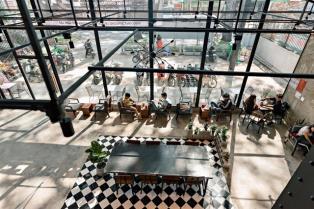The Viet Nam Railway Department has drafted plans to lease out infrastructure in the Da Lat-Trai Mat rail section to mobilise private investment for developing railway infrastructure.
 |
| The 6.7km Da Lat-Trai Mat stretch is part of the Thap Cham-Da Lat rail route built in 1932 and unused since 1972. — Photo baolamdong |
Compiled by Le Hung Vong
The Viet Nam Railway Department has drafted plans to lease out infrastructure in the Da Lat-Trai Mat rail section to mobilise private investment for developing railway infrastructure.
The lease of the first rail section aims to create a "breakthrough" in the operation of the country's railways.
The 6.7km Da Lat-Trai Mat stretch is part of the Thap Cham-Da Lat rail route built in 1932 and unused since 1972.
In 1991 the stretch was restored and put into operation again to carry visitors to Linh Ung Pagoda and nearby areas in the Central Highlands province of Lam Dong.
The meagre number of passengers served by the route and the degraded infrastructure are a burden for the railway department.
Figures from the department show that in the past three years the Da Lat -Trai Mat section has earned annual revenues of VND2.981 billion (over US$130,000), while maintenance expenses amount to VND1.27 billion ($56,700), operation expenses to VND2.691 billion (over $120,000), and infrastructure fees to VND0.28 billion per year.
"On average, the operation of the Da Lat-Trai Mat section gets a subsidy of VND983 million per year [from the Government]," Khuong The Duy, deputy chief of the railway operator, said.
"The subsidy will increase in future because infrastructure has been degrading and the number of passengers is declining."
The department has lands and other properties like the ancient villas situated inside the nearly 44,000sq.m Da Lat station at 1 Quang Trung Street.
"Mobilising funds from investors for restoring and upgrading infrastructure and locomotives to effectively operate and serve Da Lat's tourism industry is a very urgent need," Duy said.
Under the proposal by the Viet Nam Railway Department, the leasing would be divided into two phases. In phase 1, the investor will have to spend on construction, management, operation, and maintenance of the section.
In the second phase, the investor will develop tourism and hospitality facilities along the route to tap the tourism potential of the route.
New possibilities
Local companies Hoa Sen and Hoa Phat JSC have shown interest in taking over a proposed steel production complex in the central province of Quang Ngai's Dung Quat Economic Zone from a Taiwanese investor who has backed out due to financial reasons.
According to a source from the Dung Quat Economic Zone management, the investor of the Guang Lian steel plant had reported inability to raise funding for the multi-billion-dollar project a few months ago.
Hoa Sen and Hoa Phat are keen to develop their projects at the site of the Guang Lian steel project.
However, there are signs that Quang Ngai Province authorities prefer Hoa Phat, official comments made on a document on Hoa Phat's bid indicate.
Hoa Phat has proposed building a $2-2.5 billion steel plant with an annual capacity of four million tonnes in two phases.
The company plans to bring in 65 per cent of the amount and obtain bank loans for the rest.
It wants 300-350 hectares of land for the plant, and 150ha for the first phase, at the site of the suspended Guang Lian plant.
In the document, Quang Ngai officials note that Hoa Phat has experience in building and operating a 1.2 million tonne per year steel plant in the northern province of Hai Duong and the financial wherewithal to raise the needed amount.
They also believe that the 300-350ha requirement by Hoa Phat is better than the 504ha demanded by the Taiwanese company though that was to have been a 5 million tonne plant.
Hoa Phat has asked the Government for the same tax and rent incentives it offered Guang Lian.
Provincial authorities have said if Hoa Phat takes over the project and keeps the terms unchanged, it can enjoy all the incentives stated in the licence issued to Guang Lian.
But any changes to the terms of the project could see a change in the incentives too, they said, though in both cases approval would have to be obtained from the Government.
Quang Ngai authorities had earlier written to Hoa Sen after it said it wanted to build a steel plant at the location of the Guang Lian project, saying if the company invests in a new project, the incentives would be in line with new laws on land, investment and construction.
They said Hoa Sen should consider a plant with a capacity of 3-5 million tonnes since it would be appropriate for the area and the depth of the local port, they said, adding if it chooses to produce five million tonnes, it would get a maximum of 504ha, the same as Guang Lian.
Hoa sen has yet to respond.
Land prices surge
Land prices have risen on the Thanh Da-Binh Quoi peninsula in HCM City's Binh Thanh District following an announcement by city authorities that they are scouting for a new contractor to develop a VND30 trillion ($1.3 billion) ecological urban zone there.
The announcement also meant zoning plans drawn up more than 20 years, which prevented hundreds of families from building houses, have been scrapped, giving another cause for land prices to increase.
Prices of land on main roads have skyrocketed from VND6.5-10 million per square metre early this year to double or triple that now.
Tran Van Doanh, a resident of Block 1, insists on VND15 million per square metre for his 100sq.m piece of land in an alley and says no to any plea for a discount.
Truong Tan Dung, who lives on Binh Quoi Road in Ward 28, wants VND19 billion (nearly $850,000) for his 800sq.m house in the Thanh Da -Binh Quoi peninsula, saying, "I will not give a big discount because it is the going price there."
"The five bridges to be built in the near future to link Binh Quoi-Thanh Da with Districts Thu Duc, 2, and 9, will make this place bustle and the most worthy place to live in HCM City."
According to Tran Thanh Binh, a real estate division official at the Binh Thanh District People's Committee, prices of street houses in Thanh Da-Binh Quoi have risen to over VND35 million per square metre.
He said land prices were raised after the city People's Committee made the decision to find a developer for the ecological urban zone.
Le Hoang Chau, chairman of the HCM City Real Estate Association, said investors have been looking for vacant plots of land in the Binh Quoi -Thanh Da Ecological Urban Zone where the five bridges will be built.
The bridges would give the peninsula a new look and boost the city real estate market, he claimed.
Le Ba Chi Nhan, a housing analyst, said local authorities and relevant city agencies should promulgate detailed zoning plans for the project to prevent people from selling to unsuspecting buyers lands to be acquired later for public works, which would lead to disputes. —VNS





